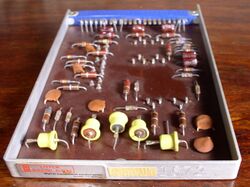System Module
System Modules (originally named System Building Blocks; the name was changed about 1961) were a DEC modular digital logic family which preceded the later FLIP CHIPs. They were used to construct all DEC's computers from the PDP-1 through the PDP-7 (which also used some FLIP CHIPs).
They connected to the units they were plugged into via a set of 22 gold-plated discrete pins along one edge. They used transistor inverter circuits, with the transistors operating saturated, to avoid dependence on tight tolerances; they ran off a supply voltage of -3V. Intended for prototyping as well as production, they included design features intended to avoid damage. They came with design advice which included loading rules, and wiring instructions.
They were available in three compatible speed lines:
- 4000-Series: the basic series, speeds ranged from 500 KHz to 1 MHz
- 1000-Series: used where extra standard output loads, or -3V sources, were needed
- 6000-Series: higher speeds, 5 MHz to 10 Mhz
In addition, special modules were available for purposes such as I/O converters (to standard internal voltages), bus drivers, lamp and solenoid drivers, A/D conversion, relays, core memory drivers, etc.
Larger assemblies which were part of the same family provided core memory testing devices, and there were also power supplies, mounting panels with slots for the modules, cabinets to hold groups of mounting panels, indicator light panels, etc, etc.
Further reading
- System Modules, Digital Equipment Corporation, Maynard, 1964
External links
- System Modules, Digital Equipment Corporation, Maynard, 1968 (C-100)
- Richard L. Best, Russell C. Doane and John E. McNamara, Digital Modules, The Basis for Computers, in C. Gordon Bell, J. Craig Mudge, John. E. McNamara, Computer Engineering: A DEC View of Hardware Systems Design, Digital Press, Bedford, 1978
